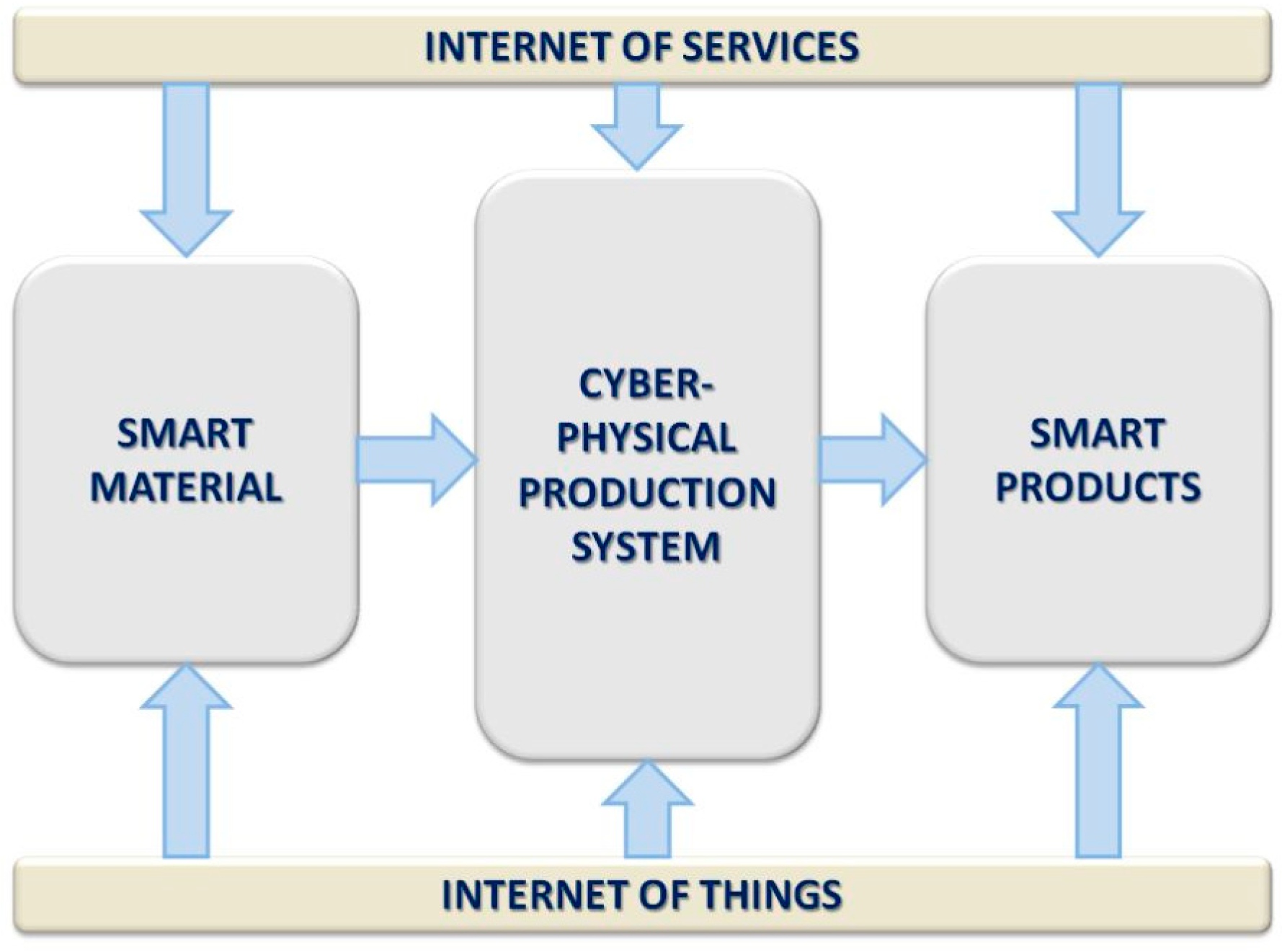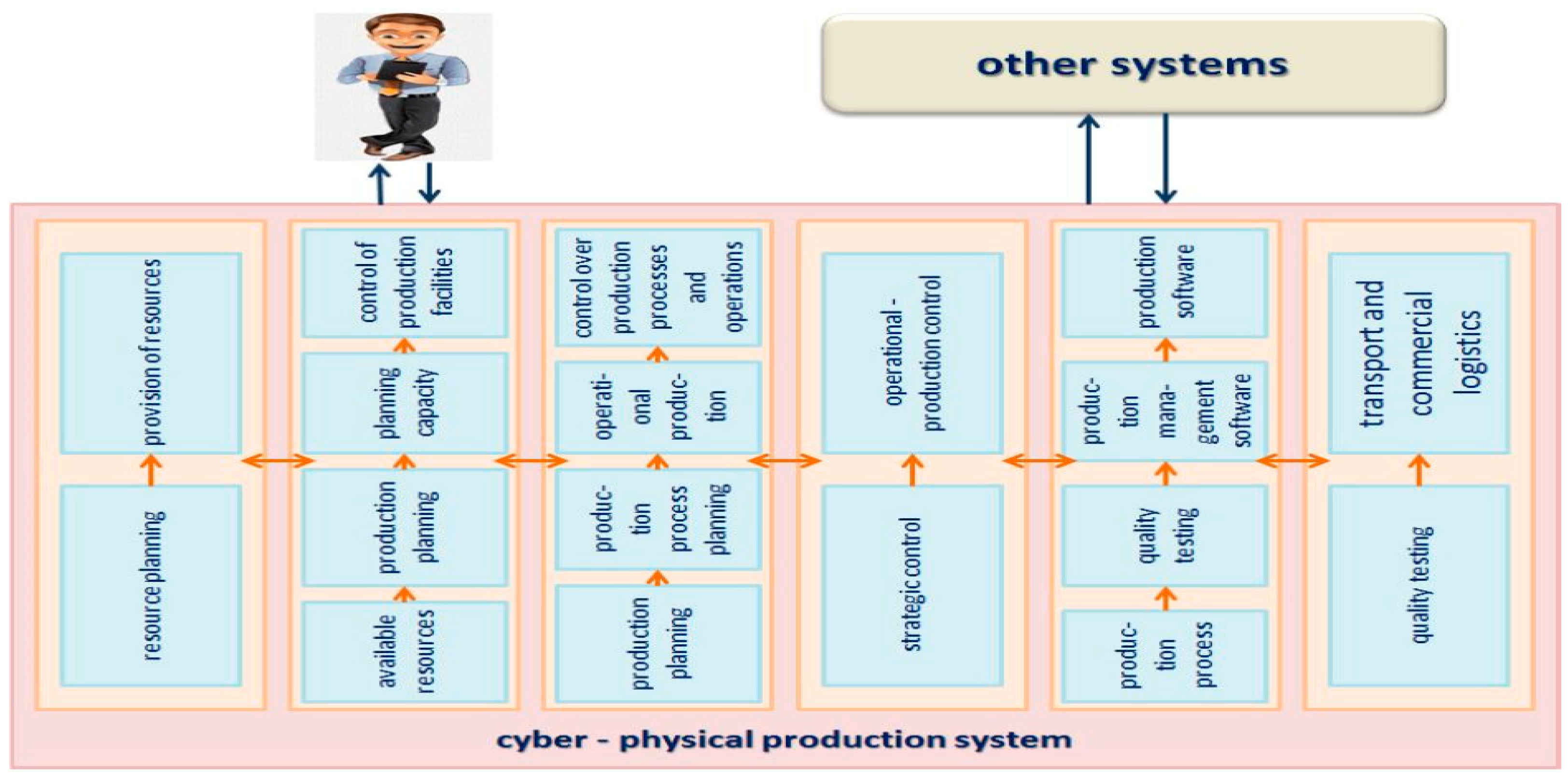Integrated Model of Production and Engineering Chains in Smart Manufacturing Technologies in Industry 4.0 †
Abstract
1. Introduction
- a concept of computer-integrated production that achieves automation of production processes based on control and data exchange in the entire production process by using computers in a closed system;
- a concept of a computer-integrated enterprise that integrates all aspects of the company in a computerized automated system and serves as a tool to support the decision making in the fields of management, engineering design, marketing, and sales;
- a concept of factory automation consisting of the implementation of technologies and systems for automating the production process to increase productivity and reduce costs, wherein the automation can involve only one operation or the entire production cycle, ignoring human intervention;
- a “just in time” concept, which is a management strategy that aligns supplies directly with the needs of the production plans and schedules, resulting in increased production efficiency and reduced waste.
- the establishment, balancing, and integration of the goals for the success of the engineering and production units in the engineering work;
- the determination of the actual or expected needs of the users of the products of a certain engineering work;
- the elaboration of a model of the life cycle of the engineering work based on the operational concept and functionality of certain processes or products;
- overcoming the complexity, uncertainty, modification, and diversity in the engineering work by implementing a process approach and effective management structures;
- the generation and evaluation of concepts and architectures for alternative solutions in the engineering work;
- the modeling of a specific decision-making architecture at each phase of the life cycle of the engineering work;
- the design synthesis, verification, and validation of the engineering work.
- to analyze its constituent systems;
- to identify the elements and their interdependencies;
- to investigate the influence of the elements of the systems in terms of the behavior and efficiency of the entire engineering work;
- to define how all factors impacting the process of development are balanced to achieve an effective result.
2. Object, Subject, Goal, and Main Tasks
- definition for the study of the concept of “engineering and production chain in the Smart factory of Industry 4.0”;
- definition of the concept of “model” for this study;
- synthesis of a model of the main engineering and production chains in the Smart factory of Industry 4.0.
3. Defining the Term “Model” for the Study
- establishes ongoing trends in the development of various socio–economic processes in the Smart factory of Industry 4.0;
- simply defines a broad system of functions, essentially expressing the most important causal relationships between the elements of the cyber–physical production system and between it and the elements of its environment;
- makes it possible to evaluate the future values of all operating variables, thus creating real prerequisites for drawing up optimal plans and developing optimal production activities;
- contains independent variables, key factors, endogenous indicators, and a set of methods that must be determined in advance [18];
- sets the specific parameters of the future development of the Smart factory of Industry 4.0 through:
- the deterministic approach based on the unambiguous calculation of the estimated quantities;
- the stochastic approach based on the relationship between the quantities corresponding to interval or intermediate forecasts.
4. Model of the Main Engineering and Production Chains in the Smart Factory of Industry 4.0
- robotized and automated real production system;
- machine-embedded system;
- sensor system;
- hardware system;
- software system;
- human factor connection system;
- system for connection with other systems.
- chain of “resource planning–provision of resources”;
- chain of “available resources–production planning–production capacity planning–control of the capabilities of production facilities”;
- chain of “production planning–production process planning–operational production–control of production processes and operations”;
- chain of “strategic control–operations and production control”;
- chain of “production process–quality testing–production management software–operations and production software”;
- chain of “quality testing–transport and commercial logistics”.
- the actual separation of autonomous and independent production processes;
- independent analysis, coordination, and regulation of these processes through self-regulated control;
- the integrated possibility of transmission, exchange of, and feedback from the information flows along the “robot -machine–human” axis.
- PLM Services enable the management of product lifecycles by quickly and easily connecting processes, people, and data throughout the product lifecycle and by capturing critical business information and integrating tools and processes to reap benefits at every stage of the product development;
- Service Control Manager is a special system process from the Windows NT family that starts, stops, and interacts with Windows service processes and allows for interaction with Service Control Manager through a defined API that enables the management of the services provided by Windows;
- CRM Services manage customer relations and are a strategy that contributes to managing customer interactions based on the streamlining of processes and the increase in profitability;
- CMS Services deliver unique software solutions for managing compliance and provide cost-saving solutions for collecting, reviewing, and sharing compliance materials and documentation at the account level;
- ERP Services are a software that connects multiple processes and enables the exchange of information between them by providing planning of enterprise resources based on day-to-day business activities such as accounting, supplies, project management, risk and compliance management, supply chain operations, enterprise performance management, planning, budgeting, forecasting, and reporting of the organization’s financial results.
5. Conclusions
- the method for extraction, storage, processing, and presentation of data;
- the approaches, mechanisms, and tools for monitoring the state of the engineering and production structure and restructuring and/or changing the processes in the Smart factory of Industry 4.0;
- the algorithms for unifying the main components, elements, and information flows that enable the processing of data in the Smart factory of Industry 4.0.
Author Contributions
Funding
Data Availability Statement
Conflicts of Interest
References
- Hozdić, E. SMART factory for Industry 4.0: A review. Int. J. Mod. Manuf. Technol. 2015, 7, 28–35. [Google Scholar]
- Manufacturing Supply Chains Explained. Available online: https://www.netsuite.com/ (accessed on 8 September 2023).
- Pietrzyk, M.; Madej, L.; Rauch, L.; Szeliga, D. Computational Materials Engineering, Achieving High Accuracy and Efficiency in Metals Processing Simulations; Elsevier Inc.: Amsterdam, The Netherlands, 2015; pp. 69–151. [Google Scholar] [CrossRef]
- Schlimbach, J.; Ogale, A. Out-of-autoclave curing process in polymer matrix composites. In Manufacturing Techniques for Polymer Matrix Composites (PMCs); Woodhead Publishing Series in Composites Science and Engineering; Woodhead Publishing: Sawston, UK, 2012; pp. 435–480. [Google Scholar]
- Levine, D.K. Production chains. Rev. Econ. Dyn. 2012, 15, 271–282. [Google Scholar] [CrossRef]
- Lopez-Cruz, O. An Essential Definition of Engineering to Support Engineering Research in the Twenty-First Century. Int. J. Philos. 2022, 10, 130–137. [Google Scholar] [CrossRef]
- Lopez-Cruz, O. Por qué historia y filosofía en las carreras de ingeniería. Hojas De El Bosque 2018, 4, 61–67. [Google Scholar] [CrossRef]
- De Vries, M.J. Engineering science as a “discipline of the particular? Types of generalization in engineering sciences. In Philosophy and Engineering; Springer: Dordrecht, The Netherlands, 2009; pp. 83–93. [Google Scholar]
- El-Zein, A.H.; Hedemann, C. Beyond problem solving: Engineering and the public good in the 21st century. J. Clean. Prod. 2016, 137, 692–700. [Google Scholar] [CrossRef]
- El-Zein, A.H.; Hedemann, C. Engineers as problem solvers: A deficient self-definition for the 21st century. In Proceedings of the 6th International Conference on Engineering Education for Sustainable Development, Cambridge, UK, 22–25 September 2013. [Google Scholar]
- Downey, G. Are engineers losing control of technology? From “problem solving” to “problem definition and solution” in engineering education. Chem. Eng. Res. Des. 2005, 83, 583–595. [Google Scholar] [CrossRef]
- Goldman, S.L. Compromised exactness and the rationality of engineering. In Social Systems Engineering: The Design of Complexity; García-Díaz, C., Olaya, C., Eds.; Wiley Series in Computational and Quantitative Social Science; Wiley: Hoboken, NJ, USA, 2017; pp. 11–30. [Google Scholar]
- Systems Engineering. Available online: https://www.incose.org/ (accessed on 15 September 2023).
- Zenkert, J.; Weber, C.; Dornhöfer, M.; Abu-Rasheed, H.; Fathi, M. Knowledge Integration in Smart Factories. Encyclopedia 2021, 1, 792–811. [Google Scholar] [CrossRef]
- Del Gallo, M.; Mazzuto, G.; Ciarapica, F.E.; Bevilacqua, M. Artificial Intelligence to Solve Production Scheduling Problems in Real Industrial Settings: Systematic Literature Review. Electronics 2023, 12, 4732. [Google Scholar] [CrossRef]
- Kuhne, T. What is a Model? ResearchGate.Net. Available online: https://www.researchgate.net/publication/30814656_What_is_a_Model (accessed on 1 January 2024).
- Zakeri, Z.; Arif, A.; Omurtag, A.; Breedon, P.; Khalid, A. Multimodal Assessment of Cognitive Workload Using Neural, Subjective and Behavioural Measures in Smart Factory Settings. Sensors 2023, 23, 8926. [Google Scholar] [CrossRef] [PubMed]
- Teplická, K.; Khouri, S.; Mudarri, T.; Freňáková, M. Improving the Quality of Automotive Components through the Effective Management of Complaints in Industry 4.0. Appl. Sci. 2023, 13, 8402. [Google Scholar] [CrossRef]
- Vogel-Heuser, B.; Bayrak, G.; Frank, U. Agenda CPS-scenario Smart Factory (Agenda CPS-Szenario smart factory). In “Increased Availability and Transparent Production” (“Erhöhte Verfügbarkeit und transparente Produktion”); Vogel-Heusser, B., Ed.; University Press: Kassel, Germany, 2014; pp. 6–21. [Google Scholar]
- Ryalat, M.; ElMoaqet, H.; AlFaouri, M. Design of a Smart Factory Based on Cyber-Physical Systems and Internet of Things towards Industry 4.0. Appl. Sci. 2023, 13, 2156. [Google Scholar] [CrossRef]




Disclaimer/Publisher’s Note: The statements, opinions and data contained in all publications are solely those of the individual author(s) and contributor(s) and not of MDPI and/or the editor(s). MDPI and/or the editor(s) disclaim responsibility for any injury to people or property resulting from any ideas, methods, instructions or products referred to in the content. |
© 2024 by the authors. Licensee MDPI, Basel, Switzerland. This article is an open access article distributed under the terms and conditions of the Creative Commons Attribution (CC BY) license (https://creativecommons.org/licenses/by/4.0/).
Share and Cite
Temelkova, M.; Bakalov, N. Integrated Model of Production and Engineering Chains in Smart Manufacturing Technologies in Industry 4.0. Eng. Proc. 2024, 60, 25. https://doi.org/10.3390/engproc2024060025
Temelkova M, Bakalov N. Integrated Model of Production and Engineering Chains in Smart Manufacturing Technologies in Industry 4.0. Engineering Proceedings. 2024; 60(1):25. https://doi.org/10.3390/engproc2024060025
Chicago/Turabian StyleTemelkova, Miglena, and Nikola Bakalov. 2024. "Integrated Model of Production and Engineering Chains in Smart Manufacturing Technologies in Industry 4.0" Engineering Proceedings 60, no. 1: 25. https://doi.org/10.3390/engproc2024060025
APA StyleTemelkova, M., & Bakalov, N. (2024). Integrated Model of Production and Engineering Chains in Smart Manufacturing Technologies in Industry 4.0. Engineering Proceedings, 60(1), 25. https://doi.org/10.3390/engproc2024060025





